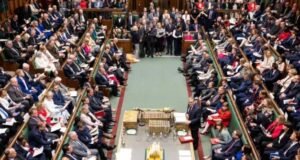 Two 5,000-strong “strike brigades” that can be rapidly deployed are to be created by 2025 to help the UK respond to “diverse” threats, the PM is to say.
Two 5,000-strong “strike brigades” that can be rapidly deployed are to be created by 2025 to help the UK respond to “diverse” threats, the PM is to say.
David Cameron will give details of an additional £12bn of equipment spending, as he outlines the Strategic Defence and Security Review in the Commons.
The extra spending will include a new fleet of marine patrol aircraft.
He will say the priority is to tackle state-based threats and terrorism, including so-called Islamic State.
It comes as he is in Paris for talks with French President Francois Hollandefollowing the 13 November attacks, claimed by IS, which left 130 people dead.
Mr Cameron is preparing to make the case to MPs in the coming week for air strikes against IS targets in Syria.
Brussels remains on the highest level of terror alert, with universities, schools and the metro shut, as police continue to hunt for the prime suspect in the Paris attacks.
In Monday’s SDSR, Mr Cameron will announce:
New strike brigades, sourced from existing Army numbers, equipped to deploy across the globe and use the army’s new generation of Ajax armoured vehicles
Nine new Boeing P8 maritime patrol aircraft, filling a gap left by the highly-criticised decision in the last review in 2010 to scrap a new generation of Nimrod aircraft
A 10-year extension to the operational lifespan of the RAF’s Typhoon jets, up to 2040, and upgrade work to give them ground attack capabilities – effectively adding two additional frontline squadrons to the nation’s air force
At-a-glance: Read more about the main announcements of the SDSR
in equipment spending takes total defence spending to £178bn over the next decade
Writing in the SDSR’s foreword, Mr Cameron said over the course of this Parliament “our priorities are to deter state-based threats, tackle terrorism, remain a world leader in cyber security and ensure we have the capability to respond rapidly to crises as they emerge”.
Defence secretary Michael Fallon told the BBC: “Painful decisions were made five years ago, the defence budget was in a mess… Now we have a stable economy we’ve made a decision to spend more on defence and less of welfare.”
He added: “We’re faced with a threat we didn’t see five years ago so we have to gear up and make sure that our armed forces haves the equipment and configuration that they need.”
What is the Strategic Defence and Security Review?
The government’s foremost document on defence strategy
Together with the National Security Strategy (NSS) report, it reviews threats to the UK and what capabilities the nation’s military needs to respond
When published, the SDSR and NSS are expected to reflect a more unstable global security environment, involving “radical jihadist groups” carrying out attacks in several countries
Russia barely featured in 2010 but is likely to merit far more attention this time
The 2010 SDSR made significant changes to the configuration of the armed forces and announced major equipment cuts
Source: House of Commons introduction to 2015 SDSR
Chancellor George Osborne has already said the purchase of new fighter jetswill be accelerated, making 24 F35 Joint Strike Fighter aircraft available on the UK’s two new aircraft carriers by 2023, rather than the previously planned eight.
The SDSR is also expected to commit the UK to purchasing 138 of F35s over a longer period of time.
The nine Boeing P8 sea patrol aircraft will be used for maritime surveillance, anti-submarine and anti-surface ship warfare.
On Sunday, it emerged that Canadian and French maritime patrol aircraft had been assisting the Royal Navy after reports a Russian submarine had been spotted off the north of Scotland.
Boeing P8
4,500 miles (7,200 km) maximum range without refuelling
490 knots (910km/h; 560mph) maximum speed
28 P-8A Poseidon aircraft in use by the United States
2 other countries, India and Australia, have variants of the aircraft in use or on order
Source: Boeing
Mr Fallon defended the previous coalition government’s decision to scrap the planned Nimrod fleet that was in development. “It wasn’t ready, that was the problem. We didn’t dispense with it – it wasn’t there,” he said.
The government has now decided to buy P8 aircraft that already exist in the US. He said British businesses would still benefit as they made parts for the planes and would have the opportunity to bid for contracts around the purchase.
Shadow defence minister Maria Eagle said she was glad to see the government was going to “put straight the botched decisions made five years ago” and make sure the UK was able to patrol its own seas.
The last defence review in 2010 will be remembered for the savage cuts inflicted on the armed forces.
The government hopes this one will be remembered for a generous splurge of cash. Ministers have already trumpeted extra resources for drones, special forces and the intelligence agencies.
Now there’s more largesse, with promises of nine new maritime patrol aircraft for the RAF, and dozens of F35 stealth jets for the Navy’s new carriers.
The government will hide any embarrassment over the fact that these are capabilities scrapped in the last defence review.
And there’ll still be disappointments. The Navy had hoped they’d be getting 13 new frigates. The initial order will be for fewer.
The government has previously announced that the SAS and other special forces will get an extra £2bn to improve their equipment.
Also, the RAF will double its number of drones, an extra £1.9bn will be spent on cyber security and 1,900 new spies will be recruited.
Mr Osborne pledged in his summer Budget to meet Nato’s target of spending 2% of national income on defence every year, up to 2020. That means spending on defence will rise in real terms – 0.5% above inflation – every year during the current Parliament.
Meanwhile, the chancellor has refused to rule out cuts to the number of frontline police officers, but says Wednesday’s Spending Review will see a 30% increase in the counter-terrorism budget.
 Weekly Bangla Mirror | Bangla Mirror, Bangladeshi news in UK, bangla mirror news
Weekly Bangla Mirror | Bangla Mirror, Bangladeshi news in UK, bangla mirror news







